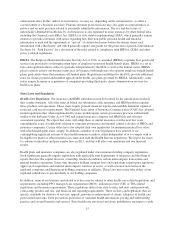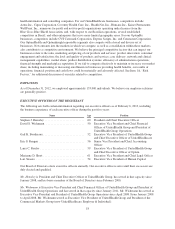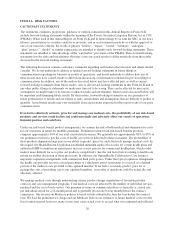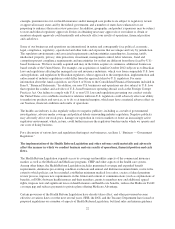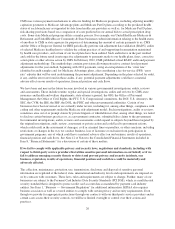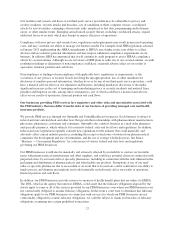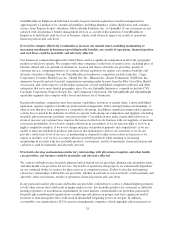United Healthcare 2012 Annual Report Download - page 23
Download and view the complete annual report
Please find page 23 of the 2012 United Healthcare annual report below. You can navigate through the pages in the report by either clicking on the pages listed below, or by using the keyword search tool below to find specific information within the annual report.in premiums or bids. These factors may include medical cost inflation, increased use of services, increased cost
of individual services, natural catastrophes or other large-scale medical emergencies, epidemics, the introduction
of new or costly treatments and technology, new mandated benefits (such as the expansion of essential benefits
coverage) or other regulatory changes and insured population characteristics. Relatively small differences
between predicted and actual medical costs or utilization rates as a percentage of revenues can result in
significant changes in our financial results. For example, if our 2012 medical costs for commercial insured
products were 1% higher, without proportionally higher revenues from such products, our annual net earnings for
2012 would have been reduced by approximately $215 million, excluding any offsetting impact from premium
rebates.
In addition, the financial results we report for any particular period include estimates of costs that have been
incurred for which claims are still outstanding. These estimates involve an extensive degree of judgment. If these
estimates prove too low, our results of operations could be materially and adversely affected.
Our business activities are highly regulated; new laws or regulations or changes in existing laws or
regulations or their enforcement or application could materially and adversely affect our results of
operations, financial position and cash flows.
Our business is regulated at the federal, state, local and international levels. Our insurance and HMO subsidiaries
must be licensed by and are subject to the regulations of the jurisdictions in which they conduct business. For
example, states require periodic financial reports and enforce minimum capital or restricted cash reserve
requirements. Health plans and insurance companies are also regulated under state insurance holding company
regulations, and some of our activities may be subject to other health care-related regulations and requirements,
including those relating to PPOs, MCOs, utilization review and TPA-related regulations and licensure
requirements. Some of our UnitedHealthcare and Optum businesses hold or provide services related to
government contracts and are subject to U.S. federal and state and non-U.S. self-referral, anti-kickback, medical
necessity, risk adjustment, false claims, debt collection and other laws and regulations governing government
contractors and the use of government funds. In addition, under state guaranty fund laws, certain health, life and
accident insurance companies and, in certain cases, HMOs can be assessed (up to prescribed limits) for certain
obligations to the policyholders and claimants of insolvent insurance companies that write the same line or lines
of business in these states, which would expose our business to the risk of insolvency of a competitor in these
states.
Certain of our Optum businesses are also subject to regulatory and other risks and uncertainties, some of which
are distinct from those faced by our insurance and HMO subsidiaries, including, for example, FDA regulations,
state telemedicine regulations and state corporate practice of medicine doctrines and fee-splitting rules, some of
which could impact our relationships with physicians, hospitals and customers. Additionally, OptumHealth
participates in the emerging private exchange markets and it is not yet known to what extent the states will issue
new regulations that apply to private exchanges. These risks and uncertainties may materially and adversely
affect our ability to market our products and services, or to do so at targeted margins, or increase the regulatory
burdens under which we operate.
The laws and rules governing our business and interpretations of those laws and rules are subject to frequent
change, and the integration into our businesses of entities that we acquire may affect the way in which existing
laws and rules apply to us. The broad latitude given to the agencies administering, interpreting and enforcing
current and future regulations governing our business could force us to change how we do business, restrict
revenue and enrollment growth, increase our health care and administrative costs and capital requirements, or
expose us to increased liability in courts for coverage determinations, contract interpretation and other actions.
We must also obtain and maintain regulatory approvals to market many of our products, increase prices for
certain regulated products and complete certain acquisitions and dispositions or integrate certain acquisitions. For
21






